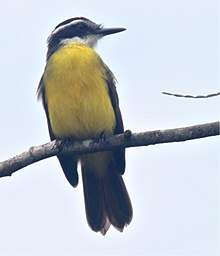Lesser kiskadee
| Lesser kiskadee | |
|---|---|
 | |
| Scientific classification | |
| Kingdom: | Animalia |
| Phylum: | Chordata |
| Class: | Aves |
| Order: | Passeriformes |
| Family: | Tyrannidae |
| Genus: | Philohydor Lanyon, W, 1984 |
| Species: | P. lictor |
| Binomial name | |
| Philohydor lictor (Lichtenstein, 1823) | |
| Synonyms | |
|
Pitangus lictor | |
The lesser kiskadee (Philohydor lictor) is a species of passerine bird in the family Tyrannidae. It is the only species in the genus Philohydor. It is found in Argentina, Bermuda, Bolivia, Brazil, Colombia, Ecuador, French Guiana, Guyana, Panama, Peru, Suriname, Trinidad, Guatemala, and Venezuela. Its natural habitats are subtropical or tropical moist shrubland and swamps.
The lesser kiskadee was described by the German naturalist and explorer Hinrich Lichtenstein in 1823 and given the binomial name Lanius lictor.[2] The present genus Philohydor was introduced by the American ornithologist Wesley Edwin Lanyon in 1984.[3] The word Philohydor is from Ancient Greek philos for "-loving" and hudōr, "water". The specific epithet lictor is the Latin word for a magistrate's bodyguard who carried out sentences.[4] It is sometimes placed in the genus Pitangus with the great kiskadee.[5]
There are two subspecies:[6]
- P. l. panamensis (Bangs & Penard, TE, 1918) – east Panama and north Colombia
- P. l. lictor (Lichtenstein, MHK, 1823) – east Colombia through the Guianas south to Bolivia, east and central Brazil
The lesser kiskadee is 15–18 cm (5.9–7.1 in) in length and weighs around 25 g (0.88 oz). It lives in eastern Panama and throughout the northern parts of South America, usually near water.[7]
References
- ↑ BirdLife International (2012). "Philohydor lictor". IUCN Red List of Threatened Species. Version 2013.2. International Union for Conservation of Nature. Retrieved 26 November 2013.
- ↑ Lichtenstein, Hinrich (1823). Verzeichniss der Doubletten des Zoologischen Museums der Königl (in German). Berlin: T. Trautwein. p. 49.
- ↑ Lanyon, Wesley Edwin (1984). A phylogeny of the kingbirds and their allies. American Museum Novitates, Number 2797. New York: American Museum of Natural History. p. 23.
- ↑ Jobling, James A. (2010). The Helm Dictionary of Scientific Bird Names. London: Christopher Helm. pp. 226, 303. ISBN 978-1-4081-2501-4.
- ↑ Dickinson, E.C.; Christidis, L., eds. (2014). The Howard & Moore Complete Checklist of the Birds of the World. Volume 2: Passerines (4th ed.). Eastbourne, UK: Aves Press. p. 48. ISBN 978-0-9568611-2-2.
- ↑ Gill, Frank; Donsker, David, eds. (2017). "Tyrant flycatchers". World Bird List Version 7.3. International Ornithologists' Union. Retrieved 17 January 2018.
- ↑ Mobley, J. (2018). del Hoyo, J.; Elliott, A.; Sargatal, J.; Christie, D.A.; de Juana, E., eds. "Lesser Kiskadee (Philohydor lictor)". Handbook of the Birds of the World Alive. Lynx Edicions. Retrieved 17 January 2018. (Subscription required (help)).
Further reading
- Dyrcz, Andrzej (2000). "Observations at nests of the Lesser Kiskadee (Philohydor lictor) on Barro Colo Rado Island (Republic of Panama)" (PDF). Ornitologia Neotropical. 11: 359–362.
- Lopes, L.E (2007). "On the range of the Lesser Kiskadee Philohydor lictor (Tyrannidae) in central-eastern Brazil". Revista Brasileira de Ornitologia. 15 (3): 433–435.
External links
| Wikimedia Commons has media related to Philohydor lictor. |
| Wikispecies has information related to Philohydor lictor |
- "Lesser Kiskadee media". Internet Bird Collection.
- Photo(bird on nest, forest), & Article Birds of Ecuador gallery at chandra.as.utexas.edu (photo)
- Lesser Kiskadee photo gallery at VIREO (Drexel University)
- Lesser Kiskadee species account at NeotropicalBirds (Cornell University)
